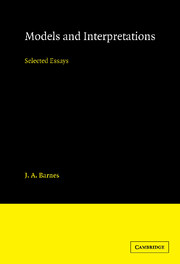Book contents
- Frontmatter
- Contents
- Preface
- Acknowledgments
- Introduction: social science in practice
- I MODELS OF THE REAL SOCIAL WORLD
- 1 Genetrix: genitor:: nature: culture? (1973g)
- 2 African models in the New Guinea highlands (1962a)
- 3 Agnatic taxonomies and stochastic variation (1971n)
- 4 Class and committees in a Norwegian island parish (1954a)
- 5 The righthand and lefthand kingdoms of God: a dilemma of Pietist politics (1971k)
- 6 Indigenous politics and colonial administration, with special reference to Australia (1960a)
- 7 The perception of history in a plural society: a study of an Ngoni group in Northern Rhodesia (1951c)
- II MODELS OF SOCIAL SCIENCE
- III A MODEL OF MODELLING
- Postscript: structural amnesia (1947: 52–3)
- Bibliography
- Index
2 - African models in the New Guinea highlands (1962a)
Published online by Cambridge University Press: 08 January 2010
- Frontmatter
- Contents
- Preface
- Acknowledgments
- Introduction: social science in practice
- I MODELS OF THE REAL SOCIAL WORLD
- 1 Genetrix: genitor:: nature: culture? (1973g)
- 2 African models in the New Guinea highlands (1962a)
- 3 Agnatic taxonomies and stochastic variation (1971n)
- 4 Class and committees in a Norwegian island parish (1954a)
- 5 The righthand and lefthand kingdoms of God: a dilemma of Pietist politics (1971k)
- 6 Indigenous politics and colonial administration, with special reference to Australia (1960a)
- 7 The perception of history in a plural society: a study of an Ngoni group in Northern Rhodesia (1951c)
- II MODELS OF SOCIAL SCIENCE
- III A MODEL OF MODELLING
- Postscript: structural amnesia (1947: 52–3)
- Bibliography
- Index
Summary
The next two chapters begin the move away from the close connexion with physical facts characteristic of kinship. Both deal with models of one type of social organization, agnatic lineages.
My apprenticeship as a field ethnographer was served in Africa, and my anthropological teachers were all Africanists. Then in 1956 I moved to a milieu where the focus of interest for most of my colleagues was the highlands of New Guinea. I was surprised to discover that their yardstick for interpreting their field data on social organization was a highly simplified lineage model allegedly realized in certain societies in Africa, but quite unlike the complicated and diversified African societies I had studied. Part of the reason for this misunderstanding, I thought, was the failure of some Africanists to emphasize sufficiently the difference between muddled configurations of actual alliance, cooperation and conflict observed in the field and the elegant structural models which supposedly underlay the muddle. When I was asked to join a symposium on Highland kinship systems at the 10th Pacific Science Congress in 1961,1 therefore wrote an article aimed at highlighting the differences between observed complex social configurations in New Guinea and simplistic African models. I also suggested, albeit rather timidly, that some Africanists had fallen into the same trap as their colleagues working in Melanesia.
The paper was rejected by three journals before being accepted for publication in Man. It has been variously described as equivalent to the refutation of Lysenko's theories (Lawrence 1972: 263) and as probably an enormous red herring (Riviere 1972) […].
- Type
- Chapter
- Information
- Models and InterpretationsSelected Essays, pp. 44 - 55Publisher: Cambridge University PressPrint publication year: 1990
- 1
- Cited by



